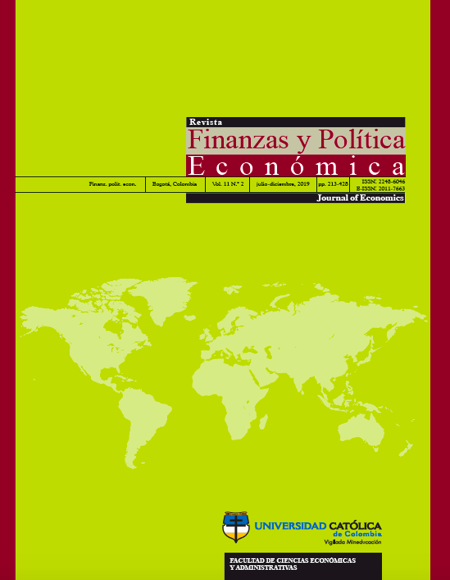This journal is licensed by a Creative Commons Attribution License (CC BY-NC-SA 4.0) Attribution-Non Commercial 4.0 International. For the CC licenses, the principle isthe creative freedom. This system complements the copyright without opposing it, conscious of its importance in our culture. The content of the articles is the responsibility of each author, and does not compromise in any way, to the journal or the university. It allows the transmission and reproduction of titles, abstracts and full content, with academic, scientific, cultural ends, provided acknowledgment of the respective source. This work cannot be used for commercial purposes.
They journal does not charge authors for submission or publication.
Abstract
This paper aims to determine the impact of political risk on private investment in Peru. Therefore, the methodology used to achieve this goal is an econometric estimation through an autoregressive distributed lag model (ARDL) from the second quarter of 1992 to the second quarter of 2018 (1992q2 – 2018q2). The paper takes into consideration i) the short- and long-run effects of political risk and ii) whether this risk could be influenced by political regimes. The results show that political risk does not have a significant impact on private investment, neither in the short nor in the long run. In the long run, private investment significatively depends on real GDP, real exchange rate, and the price of copper, while in the short run real GDP is the most important variable. Moreover, the results show that political regime, be that democratic or
not, does not have an impact on the evolution of private investment.
Keywords

References
Aysan A. F. y Veganzones, M. A. (2007). How do political and governance institutions affect private investment decisions? An application to the Middle East and North Africa. Estambul: Boğaziçi University. http://ideas.econ.boun.edu.tr/RePEc/pdf/200705.pdf
Azam, M., Khan, M. A. y Iqbal, N. (2012). Impact of political risk and uncertainty on FDI in South Asia. Transition Studies Review, 19(1), 59-77. http://doi.org/10.1007/s11300-012-0230-x
Banco Central de Reserva del Perú (s. f.). Estadísticas de balanza comercial. https://estadisticas.bcrp.gob.pe/estadisticas/series/anuales/balanza-comercial
BBVA Research (2017). Tensiones políticas y su impacto en variables financieras y reales. https://www.bbvaresearch.com/wp-content/uploads/2017/05/Peru_tensiones_politicas_economia.pdf
Bekaert, G., Harvey, C. R., Lundblad, C. T. y Siegel, S. (2014). Political risk spreads. Journal of International Business Studies, 45(4), 471-493. http://doi.org/10.1057/jibs.2014.4
Cámara de Comercio de Lima (CCL) (2018). 2018: no más confrontaciones. La Cámara. La Revista de la CCL, 809. https://www.camaralima.org.pe/repositorioaps/0/0/par/edicion809/edicion_809.pdf
Gallardo, J., Ghezzi, P. y Segura, A. (2018, 10 de octubre). Ruido de corto plazo, ganancia de largo plazo. Diario Gestión. http://gestion.peruquiosco.pe/m/a/20181010/12
Khan, M. M. y Akbar, M. I. (2013). The impact of political risk on foreign direct investment. International Journal of Economics and Finance, 5(8), 147-156. http://doi. org/10.5539/ijef.v5n8p147
Levitsky, S. y Way, L. (2004). Elecciones sin democracia. El surgimiento del autoritarismo competitivo. Estudios Políticos, 24, 159-176. https://revistas.udea.edu.co/index.php/estudiospoliticos/article/view/1368
Lipinsky, F., Ross, K., Tashu, M., Vtyurina, S. y Fenochietto R. (2015). Peru: Selected Issues [IMF Country Report 15/134]. https://www.imf.org/external/pubs/ft/scr/2015/ cr15134.pdf
Marrero, D. (2018, 19 de marzo). Percepción de riesgo país alcanza pico máximo en el año por tensión política. Diario Gestión. http://gestion.peruquiosco.pe/m/a/20180319/2
Matthee, H. (2011). Political risk analysis. En B. Badie, D. Berg-Schlosser y L. Morlino (Eds.), International encyclopedia of political science. Thousand Oaks: SAGE Publications. http://dx.doi.org/10.4135/9781412959636.n457
Mendoza, W. (2017, 21 de noviembre). Salvo el cobre, todo es ilusión. Diario El Comercio. https://elcomercio.pe/economia/opinion/salvo-precio-cobre-ilusionwaldo-mendoza-noticia-475423-noticia/
Mendoza, W. y Collantes, E. (2018). The determinants of private investment in a mining export economy. Peru: 1997-2017. Lima: Universidad Católica del Perú. http://files.pucp.edu.pe/departamento/economia/DDD463.pdf
Mongilardi, M. (2018). Debemos iniciar el 2018 con una nueva mentalidad. La Cámara, La Revista de la CCL, 809. https://www.camaralima.org.pe/repositorioaps/0/0/par/edicion809/edicion_809.pdf-475423-noticia/
Moody’s (2017, 18 de diciembre). Vamos a tener que recortar nuestra previsión al 3 % y puede ser algo mayor. Diario Gestión. http://gestion.peruquiosco.pe/m/a/20171218/20
Nasreen, S. y Anwar, M. (2014). Political risk and foreign direct investment: Evidence from Pakistan economy. International Journal of Social and Economic Research, 4(1), 24-36. http://doi.org/10.5958/j.2249-6270.4.1.005
Pesaran, M. H. y Shin, Y. (1999). An autoregressive distributed lag modelling approach to cointegration analysis. En S. Strom (Ed.), Econometrics and economic theory in the 20th century: The Ragnar Frish Centennial Symposium (pp. 371-413). Cambridge: Cambridge University Press. http://citeseerx.ist.psu.edu/viewdoc/download?doi=10.1.1.153.3246&rep=rep1&type=pdf
Pesaran, M. H., Shin, Y. y Smith, R. J. (2001). Bounds testing approaches to the analysis of level relationships. Journal of Applied Econometrics, 16(3), 289-326. http://doi.org/10.1002/jae.616
The Political Risk Service Group (2012). International country risk guide methodology. Nueva York: PRS Group. https://www.prsgroup.com/wp-content/uploads/2012/11/icrgmethodology.pdf





























